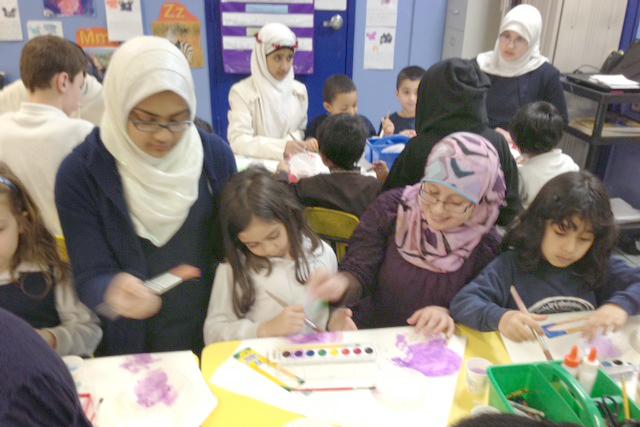In a small office tucked away on the third f loor of the masjid, or mosque, on Ligon street sits Al-Iman School principal, Mussarut Jabeen. Covering the bright ly decorated walls are photos of beaming students. In the halls children laugh as the f ina l bell r ings and they gather their things to go home.
Estab l i shed in 1992, Al- Iman school is a private pre-K through eighth grade Islamic school that works to balance traditional Islamic teachings with the common course standards for reading and math.
This year Al-Iman will be celebrating its 21st-year anniversary with an open house for the entire com munity. The school’s parent organization is the masjid, and Al-Iman falls under the umbrella of the Islamic As sociation of Raleigh, but the school is entirely funded by the community.
“It’s really interesting to see how people living in the same city they have heard about the masjid and the school but they didn’t know what we are doing, how we func tion and what our goal is,” Jabeen said. “So once they come they are surprised.”
To integrate standard common courses with religious teach ings, Al-Iman School looks for topics that can be used universally across its various classes. Teachers work with one another to find common ties within these topics that make the fusion of religious and common course subjects possible.
“Topics can be based on a unit they’re teaching and the objectives that they have to meet because, of course, the teachers are trained to use the common course stan dards goals and objectives,” Jabeen said. “A language arts teacher can see what the Is lamic studies teacher is do ing and the Islamic studies teacher can see what the lan guage arts teacher is doing.”
The children learn Arabic as their foreign language. Al though a majority of the stu dents come from an Arabic speaking background, Jabeen said that there is a difference between spoken Arabic and classical Arabic.
“Spoken Arabic is different from classical Arabic just like English,” Jabeen said. “The English that Shakespeare used, the language that he used, you know, a common person would not understand the poetry or the literary work that he created. That ap plies to any other language.”
The classical Arabic taught to the students is the language of the Islamic holy book, the Quran, which is best known as Uthmani Script.
Al-Iman also partners with other schools such as the Quaker school, Carolina Friends School in Durham and the B’nai Shalom Day School in Greensboro.
“It’s really nice to have this diversity where people want to come and visit us and we go and visit them,” Jabeen said. “Our students work really well together.”
Jabeen said the Al-Iman School puts an emphasis on teaching its students about all kinds of cultures and re ligions.
“It’s so exciting because di versity, that’s what really adds color to the canvas,” Jabeen said. “I love it when you see children from different back grounds — that’s how they learn to get along with each other. That’s how they learn that people might be differ ent and eventually once they are in the work force they’re not going to be just with their group.”
Jabeen said that this type of exposure is important because after eighth grade students become assimilated into either public school or other private schools.
“People have certain per spectives because there’s no exposure,” Jabeen said. “We wanted our children to learn about other cultures, other religions. It’s not like we want to keep them in a bubble.”
According to Jabeen, who has taught at Al-Iman for five years and then worked in the administration for eight, the community has blossomed in ways she never imagined.
Jabeen said that while 90 to 95 percent of Al-Iman’s students come from Arab country backgrounds, the de mographic is changing with time. There are now students from India, Pakistan, Bangla desh and West Africa.
Jabeen said that it’s Al- Iman’s duty to properly prepare students with the education they need to go out into the world as well as the cultural understanding, all of which they learn in their blended teachings.
“These little children they don’t look to see what skin color they are, what language they speak, are they rich are they poor, what language their friend is speaking,” Ja been said. “I tell them this: when we fall down and cut ourselves what color is our blood? Red. Our blood is not purple, or green or blue, it’s red. No matter what we are on the outside we’re all the same on the inside. That’s what matters.”








